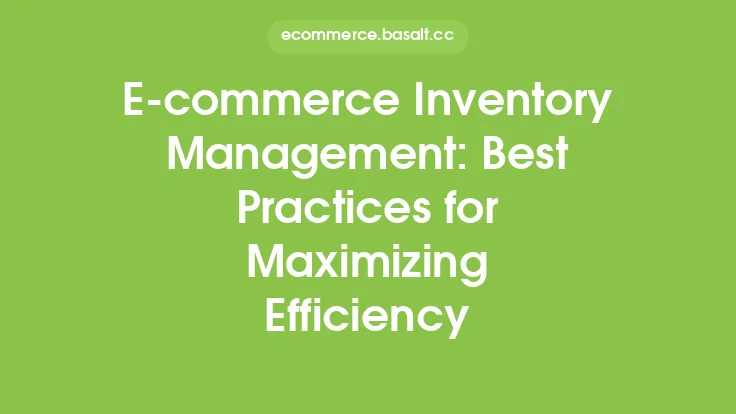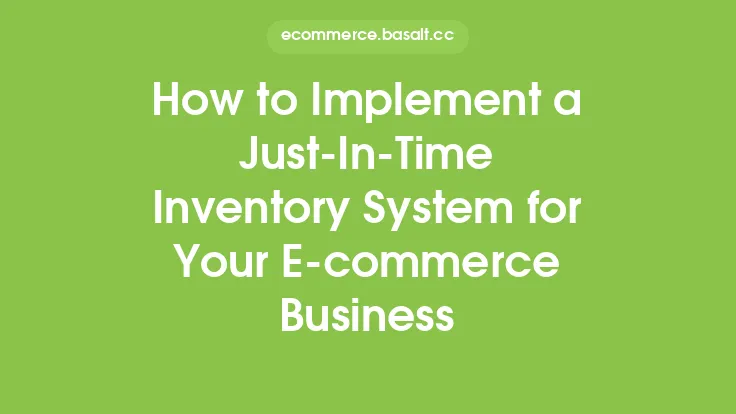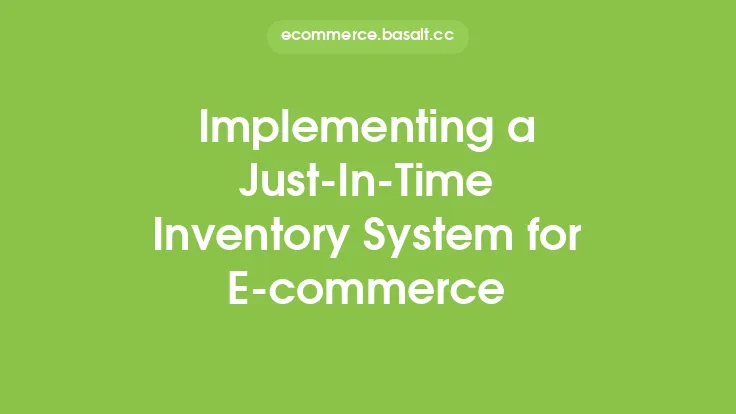Managing inventory is a crucial aspect of e-commerce that can make or break a business. It involves balancing the need to have enough stock to meet customer demand with the need to avoid overstocking, which can lead to waste and unnecessary expenses. In this article, we will explore the best practices for managing inventory in e-commerce, including the importance of accurate forecasting, effective inventory tracking, and efficient order fulfillment.
Introduction to Inventory Management
Inventory management is the process of planning, organizing, and controlling the flow of goods from raw materials to finished products. It involves managing the inventory levels, tracking the movement of goods, and ensuring that the right products are available at the right time to meet customer demand. Effective inventory management is critical to the success of an e-commerce business, as it can help to reduce costs, improve customer satisfaction, and increase profitability.
Setting Up an Inventory Management System
To manage inventory effectively, e-commerce businesses need to set up a robust inventory management system. This system should be able to track inventory levels, monitor stock movements, and provide real-time updates on product availability. The system should also be able to integrate with other business systems, such as accounting and customer relationship management (CRM) software. Some popular inventory management systems for e-commerce include TradeGecko, Zoho Inventory, and Skubana.
Forecasting and Demand Planning
Accurate forecasting and demand planning are critical components of effective inventory management. E-commerce businesses need to be able to predict demand for their products and adjust their inventory levels accordingly. This can be done by analyzing historical sales data, seasonality, and market trends. Businesses can also use forecasting tools, such as Google Analytics and Forecastly, to help them make more accurate predictions.
Inventory Tracking and Monitoring
Inventory tracking and monitoring are essential for ensuring that inventory levels are accurate and up-to-date. E-commerce businesses should use a combination of manual and automated tracking methods, such as barcode scanning and radio-frequency identification (RFID) tags, to track inventory movements. They should also regularly conduct inventory audits to ensure that inventory levels are accurate and to identify any discrepancies.
Order Fulfillment and Shipping
Order fulfillment and shipping are critical components of the e-commerce supply chain. E-commerce businesses need to be able to fulfill orders quickly and efficiently, while also ensuring that products are shipped to customers in a timely and cost-effective manner. This can be done by implementing a robust order fulfillment system, such as ShipStation or Fulfillment by Amazon (FBA), and by using shipping carriers that offer fast and reliable delivery options.
Inventory Optimization Strategies
Inventory optimization strategies can help e-commerce businesses to reduce costs, improve customer satisfaction, and increase profitability. Some popular inventory optimization strategies include just-in-time (JIT) inventory management, drop shipping, and product bundling. JIT inventory management involves ordering and receiving inventory just in time to meet customer demand, while drop shipping involves shipping products directly from the supplier to the customer. Product bundling involves offering multiple products together at a discounted price, which can help to reduce inventory levels and improve customer satisfaction.
Managing Inventory Across Multiple Channels
E-commerce businesses that sell products across multiple channels, such as online marketplaces and social media platforms, need to be able to manage their inventory across all channels. This can be done by implementing a multi-channel inventory management system, such as ChannelAdvisor or Sellbrite, which can help to track inventory levels and synchronize product listings across all channels.
Common Inventory Management Mistakes to Avoid
There are several common inventory management mistakes that e-commerce businesses should avoid. These include overstocking, understocking, and failing to track inventory levels accurately. Overstocking can lead to waste and unnecessary expenses, while understocking can lead to lost sales and disappointed customers. Failing to track inventory levels accurately can lead to inventory discrepancies and stockouts.
Best Practices for Inventory Management
Some best practices for inventory management include regularly reviewing and updating inventory levels, implementing a first-in-first-out (FIFO) inventory management system, and using inventory management software to track and manage inventory. E-commerce businesses should also regularly conduct inventory audits to ensure that inventory levels are accurate and to identify any discrepancies. Additionally, businesses should consider implementing a vendor-managed inventory (VMI) system, which can help to reduce inventory levels and improve supply chain efficiency.
Conclusion
Managing inventory is a critical aspect of e-commerce that can make or break a business. By following the best practices outlined in this article, e-commerce businesses can reduce costs, improve customer satisfaction, and increase profitability. Effective inventory management involves balancing the need to have enough stock to meet customer demand with the need to avoid overstocking, which can lead to waste and unnecessary expenses. By implementing a robust inventory management system, accurately forecasting demand, and efficiently fulfilling orders, e-commerce businesses can stay ahead of the competition and achieve long-term success.





